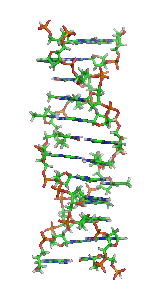Z-DNA
Z-DNA is a form of DNA helix that is distinct from the more commonly known B-DNA form. Z-DNA is left-handed, meaning that the helix winds to the left in a zigzag pattern, whereas B-DNA is right-handed. This form of DNA was discovered in the early 1970s and is characterized by its zigzag-shaped backbone, hence the name Z-DNA. It is less common than B-DNA and is thought to play a role in the regulation of gene expression, DNA replication, and DNA repair processes.
Structure[edit | edit source]
Z-DNA is formed by the alternation of purine and pyrimidine bases, specifically in sequences where cytosine (C) and guanine (G) alternate. This alternation causes the molecule to adopt a more elongated and narrow shape compared to B-DNA. The sugar-phosphate backbone of Z-DNA forms a zigzag pattern, and the grooves of the helix are more narrow and deep compared to those in B-DNA. The helical structure of Z-DNA contains about 12 base pairs per turn, and it is stabilized by the formation of a unique type of hydrogen bond and the presence of metal ions such as magnesium.
Biological Significance[edit | edit source]
The biological role of Z-DNA has been a subject of research since its discovery. It is believed that Z-DNA can form in vivo under physiological conditions, particularly in regions of high genetic activity. Z-DNA formation is influenced by supercoiling and can occur transiently in response to biological activities that induce torsional stress in the DNA molecule. This form of DNA is thought to play a role in the regulation of transcription, as certain proteins that bind specifically to Z-DNA have been identified. These proteins can influence gene expression by modifying the structure of chromatin and affecting the accessibility of DNA to transcription factors.
Z-DNA is also implicated in the process of genetic recombination and DNA repair. The formation of Z-DNA may facilitate the recognition and processing of genetic information during these critical cellular processes. Additionally, there is evidence to suggest that Z-DNA may play a role in the immune response, as sequences capable of forming Z-DNA are enriched in regions of the genome involved in immune function.
Research and Applications[edit | edit source]
Research on Z-DNA has led to the development of Z-DNA-specific antibodies, which have been used as tools to study the occurrence and function of Z-DNA in cells. These studies have provided insights into the dynamic nature of DNA and its structural variations in different biological contexts. Furthermore, understanding the mechanisms by which Z-DNA influences gene expression and DNA metabolism could have implications for the development of novel therapeutic strategies, particularly in the fields of genetic diseases and cancer.
Conclusion[edit | edit source]
Z-DNA adds to the complexity of DNA structure and function, representing a fascinating aspect of molecular biology that challenges the traditional view of DNA as a static and uniform entity. Its discovery underscores the versatility of DNA and opens up new avenues for research into the regulation of gene expression and the molecular mechanisms underlying various biological processes.
Navigation: Wellness - Encyclopedia - Health topics - Disease Index - Drugs - World Directory - Gray's Anatomy - Keto diet - Recipes
Search WikiMD
Ad.Tired of being Overweight? Try W8MD's physician weight loss program.
Semaglutide (Ozempic / Wegovy and Tirzepatide (Mounjaro) available.
Advertise on WikiMD
WikiMD is not a substitute for professional medical advice. See full disclaimer.
Credits:Most images are courtesy of Wikimedia commons, and templates Wikipedia, licensed under CC BY SA or similar.Contributors: Prab R. Tumpati, MD




